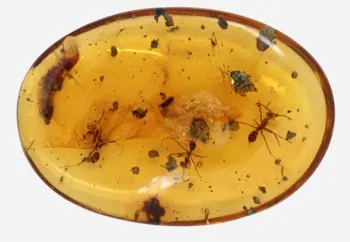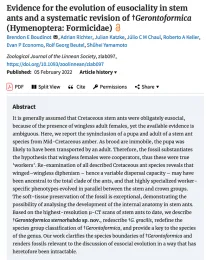International Research Team Led by Brendon Boudinot: 'Missing Link' in Ant Evolution

The research appears in the February edition of the Zoological Journal of the Linnean Society.
The fossil, from the Cretaceous geological period and now part of the American Museum of Natural History collection, “was an extremely cool find,” said Boudinot, who is researching evolutionary and comparative anatomy in Jena under a two-year Alexander von Humboldt Research Fellowship. He received his UC Davis doctorate in entomology in 2020.
Boudinot, the lead researcher and corresponding author of the paper, describes the fossil as a “relatively large piece of Kachin amber containing three wingless adult female ants plus a wingless pupa.”
“The key points are that there is a remarkable diversity of evolutionarily intermediate or ‘missing link' ants in the Cretaceous fossil record, and folks have basically assumed that they were eusocial because wingless females—presumptive workers—had been found,” Boudinot said. “The fossil we discovered cuts through the uncertainty because of the pupa; this is the first ever pupa found from Mesozoic fossils, and we confirmed through the use of cutting-edge technology (µ-CT) that it is from the same species as one of the adults. Because pupae are immobile, it is reasonable that she was dropped during transportation by the adult wingless female.”
“Importantly, the transport of larvae and pupae--termed “brood transport”--is a unique feature of ants among all Hymenoptera, and is a critical social behavior,“ Boudinot said. “This fossil is the first evidence of nursing by wingless females, very strongly indicating that advanced social organization had evolved before the origin of the modern ants in the Early Cretaceous.”

“Taken altogether, this fossil opens a totally new pathway for the study of arthropod evolution: Paleoanatomy and paleosociobiology. There is far more to learn from fossils than previously realized!”
The focal amber piece originated from a deposit in theHukawng Valley,Kachin State, northern Myanmar, dated near the Albian–Cenomanian boundary.

Co-authors are Adrian Richter and Rolf Georg Beutel, Friedrich Schiller University Jena; Julian Katzke, Roberto Keller and Evan Economo, Okinawa Institute of Science and Technology Graduate University, Japan; Júlio C M Chaul, Federal University of Viçosa, Brazil; and Shûhei Yamamoto of Hokkaido University Museum, Hokkaido University.
Yamamoto discovered the fossil, Richter and Katzke generated and rendered the µ-CT data, and Beutel, Chaul and Economo were integral for shaping the conclusions, Boudinot said. “The study also represents a breakthrough in the application of µ-CT technology for taxonomy, as we were able to make very precise comparisons among the fossilized individuals, allowing me to revise the classification of the genus †Gerontoformica.”
Globally, there are more than 14,000 described species of ants, Boudinot says "As a community, we usually throw around the figure 20,000 as our rough total estimate for three reasons: (1) there is an incredible diversity of ants in tropical ecosystems that have yet to be formally named, (2) modern sequencing technology is allowing us to gain deep insights into the population structure and relationships of living species, thus revealing considerable hidden species-level diversity, and (3) there are over a thousand subspecies names in the ant literature which need to be re-evaluated as these could actually represent proper species. There is a ton of work to do, and Phil Ward and folk are making tremendous progress!"
Regarding extinct species, Boudinot says here are "almost as many fossil ants described as non-avian dinosaurs! As of today, the number stands at about 746 fossil species; of these, only about 50 are described from Mesozoic fossil deposits. This small fraction is critical, however, as they are the key to understanding the patterns of early evolution in the ants!"
